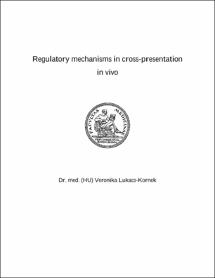Lukacs-Kornek, Veronika: Regulatory mechanisms in cross-presentation in vivo. - Bonn, 2007. - Dissertation, Rheinische Friedrich-Wilhelms-Universität Bonn.
Online-Ausgabe in bonndoc: https://nbn-resolving.org/urn:nbn:de:hbz:5N-11618
Online-Ausgabe in bonndoc: https://nbn-resolving.org/urn:nbn:de:hbz:5N-11618
@phdthesis{handle:20.500.11811/3140,
urn: https://nbn-resolving.org/urn:nbn:de:hbz:5N-11618,
author = {{Veronika Lukacs-Kornek}},
title = {Regulatory mechanisms in cross-presentation in vivo},
school = {Rheinische Friedrich-Wilhelms-Universität Bonn},
year = 2007,
note = {Dendritic cells can present exogenous antigen to CD8 T cells using a mechanism termed cross-presentation. This mechanism is important for immune responses against tumors, viruses, intracellular pathogens and autoantigens expressed in peripheral tissues. However, the physiological mechanisms that regulate cross-presentation in vivo in particular the endocytosis mechanisms involved in this process are not well understood.
The first aim of this study was to elucidate the role of the mannose receptor (MR), a C-type lectin in cross-presentation. MR deficient mice showed reduced uptake of soluble OVA and diminished activation of CD8 T cells. This was due to the reduced cross-presentation ability of DCs in MR deficient mice, as the MR was only present in the cross-presenting CD8α+ DCs. As opposed to soluble OVA, the cell-associated form of this model antigen did not use the MR to enter the cross-presentation pathways. These data provide first formal evidences that a particular antigen uptake receptor, here the MR can specifically introduce antigen into the cross-presentation pathway. Furthermore, they identify this receptor as a further marker of cross-presenting DCs.
The second aim of the present study was to identify the mechanisms by which soluble antigens are transported from the peripheral organs to draining LNs for subsequent cross-presentation. Proteins smaller than the molecular weight of albumin, such as soluble OVA theoretically may pass the kidney glomerular filter and be concentrated in the tubular compartment. It appeared possible that this physiological process might increase the availability of antigen for the cross-presenting APC. Therefore the kidney - renal lymph node (rLN) system was choosen to investigate antigen transport from organ to draining LN. Several lines of independent evidence indicated that soluble OVA was concentrated in the kidney DCs but was transported in a cell-independent fashion to DC resident in the rLN. Further studies showed that these DCs tolerized specific T cells. This tolerization was independent from steady-state migration of kidney DC to draining LN. These findings identify the rLN as a unique site where antigen is rapidly enriched for T cell activation; provided it is small enough to pass the glomerular filter. This mechanism may contribute avoiding unwanted immune responses against innocuous circulating antigens, for example self-serum or food proteins.
In conclusion the present study revealed new in vivo mechanisms in regulating cross-presentation of soluble molecules such as antigen uptake via MR and antigen presentation occurring in the kidney – renal LN system.},
url = {https://hdl.handle.net/20.500.11811/3140}
}
urn: https://nbn-resolving.org/urn:nbn:de:hbz:5N-11618,
author = {{Veronika Lukacs-Kornek}},
title = {Regulatory mechanisms in cross-presentation in vivo},
school = {Rheinische Friedrich-Wilhelms-Universität Bonn},
year = 2007,
note = {Dendritic cells can present exogenous antigen to CD8 T cells using a mechanism termed cross-presentation. This mechanism is important for immune responses against tumors, viruses, intracellular pathogens and autoantigens expressed in peripheral tissues. However, the physiological mechanisms that regulate cross-presentation in vivo in particular the endocytosis mechanisms involved in this process are not well understood.
The first aim of this study was to elucidate the role of the mannose receptor (MR), a C-type lectin in cross-presentation. MR deficient mice showed reduced uptake of soluble OVA and diminished activation of CD8 T cells. This was due to the reduced cross-presentation ability of DCs in MR deficient mice, as the MR was only present in the cross-presenting CD8α+ DCs. As opposed to soluble OVA, the cell-associated form of this model antigen did not use the MR to enter the cross-presentation pathways. These data provide first formal evidences that a particular antigen uptake receptor, here the MR can specifically introduce antigen into the cross-presentation pathway. Furthermore, they identify this receptor as a further marker of cross-presenting DCs.
The second aim of the present study was to identify the mechanisms by which soluble antigens are transported from the peripheral organs to draining LNs for subsequent cross-presentation. Proteins smaller than the molecular weight of albumin, such as soluble OVA theoretically may pass the kidney glomerular filter and be concentrated in the tubular compartment. It appeared possible that this physiological process might increase the availability of antigen for the cross-presenting APC. Therefore the kidney - renal lymph node (rLN) system was choosen to investigate antigen transport from organ to draining LN. Several lines of independent evidence indicated that soluble OVA was concentrated in the kidney DCs but was transported in a cell-independent fashion to DC resident in the rLN. Further studies showed that these DCs tolerized specific T cells. This tolerization was independent from steady-state migration of kidney DC to draining LN. These findings identify the rLN as a unique site where antigen is rapidly enriched for T cell activation; provided it is small enough to pass the glomerular filter. This mechanism may contribute avoiding unwanted immune responses against innocuous circulating antigens, for example self-serum or food proteins.
In conclusion the present study revealed new in vivo mechanisms in regulating cross-presentation of soluble molecules such as antigen uptake via MR and antigen presentation occurring in the kidney – renal LN system.},
url = {https://hdl.handle.net/20.500.11811/3140}
}






